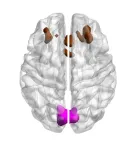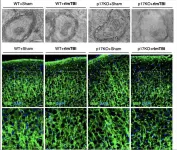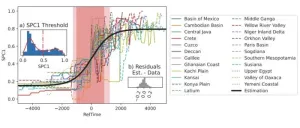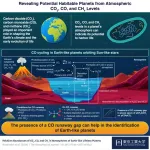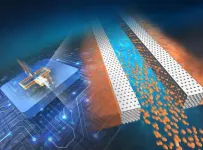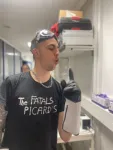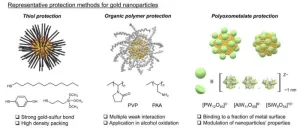(Press-News.org) Be front and center for the hottest research findings in the molecular life sciences at Discover BMB, the annual meeting of the American Society for Biochemistry and Molecular Biology, to be held March 23–26 in San Antonio.
Don’t miss this opportunity to hear from the top minds in the field. Reporters are invited to register for a complimentary press pass to attend #DiscoverBMB in San Antonio or access press materials electronically. Please note that only a limited number of complementary on-site press passes will be issued, so advance registration is recommended. Find more information in the #DiscoverBMB newsroom.
As part of an exciting program spotlighting the latest advances and trends in biochemistry and molecular biology, #DiscoverBMB will showcase a stimulating group of high-profile speakers. These include:
Asiya Gusa, Duke University
As climate change brings hotter summers, stronger storms and wilder fires to our doorsteps, pathogens are also finding their way into new places, posing increased health risks. Gusa examines how this dynamic is playing out in her studies of how the pathogenic fungus Cryptococcus neoformans responds to heat stress and other environmental cues. She also helped separate fact from fiction in HBO’s “The Last of Us” in an interview with NPR. (Biochemistry and climate change, Sunday, March 24, 1:50 p.m.–4:15 p.m. CDT)
John Whitney, McMaster University
Learning microbial lingo could help us get the upper hand in the quest to outsmart pathogens. Like a microbial codebreaker, Whitney is deciphering the signals through which microbes communicate and interact. His team recently discovered that the bacteria responsible for hospital-acquired infections such as pneumonia secrete a toxin that kills other species of bacteria by rendering their RNA nonfunctional — knowledge that could be leveraged to bolster our own arsenal of antibiotics. (Microbial communities, Tuesday, March 26, 1:50 p.m.–4:15 p.m. CDT)
Lydia Finley, Memorial Sloan Kettering Cancer Center
Finley’s lab investigates how cellular metabolic pathways regulate cell fate decisions in stem cells and cancer cells. Her plenary lecture, “Identifying and exploiting cell-state dependent metabolic networks” will examine emerging trends and insights into the metabolic pathways that make or break a cell’s success. (Plenary session, Tuesday, March 26, 11:35 a.m.–12:35 p.m. CDT)
Shuying Sun, Johns Hopkins University
Problems with RNA regulation play an important role in neurodegenerative diseases such as amyotrophic lateral sclerosis (ALS). After becoming fascinated by the complexity of RNA processing in the nervous system, Sun decided to delve into its potential role in instigating neurodegeneration. Her team recently reported important insights into how a specific gene mutation can lead to RNA dysregulation and ultimately ALS. The findings could lead to new ALS therapies that target RNA. (RNA and disease, Tuesday, March 26, 1:50 p.m.–4:15 p.m. CDT)
Even more renowned speakers will be presenting during the #DiscoverBMB awards lectures.
Follow #DiscoverBMB on Facebook, X, Instagram and LinkedIn.
Contact:
Anne Johnson
(571) 271-1986 (mobile)
media@asbmb.org
About the American Society for Biochemistry and Molecular Biology (ASBMB)
The ASBMB is a nonprofit scientific and educational organization with more than 12,000 members worldwide. Founded in 1906 to advance the science of biochemistry and molecular biology, the society publishes three peer-reviewed journals, advocates for funding of basic research and education, supports science education at all levels, and promotes the diversity of individuals entering the scientific workforce. www.asbmb.org
Questions? Contact us at media@asbmb.org
END
Scientists have found the strongest evidence yet that our brains can compensate for age-related deterioration by recruiting other areas to help with brain function and maintain cognitive performance.
As we age, our brain gradually atrophies, losing nerve cells and connections and this can lead to a decline in brain function. It’s not fully understood why some people appear to maintain better brain function than others, and how we can protect ourselves from cognitive decline.
A widely accepted notion is that some people’s brains are able to compensate ...
LA JOLLA, CA—La Jolla Institute for Immunology (LJI) is working to guide the development of new tuberculosis vaccines and drug therapies.
Now a team of LJI scientists has uncovered important clues to how human T cells combat Mycobacterium tuberculosis, the bacterium that causes TB. Their findings were published recently in Nature Communications.
"This research gives us a better understanding of T cell responses to different stages in tuberculosis infection and helps us figure out is there are additional diagnostic ...
Repeat concussions, also referred to as repetitive mild traumatic brain injury, can lead to chronic traumatic encephalopathy (CTE) and raise the risk of Alzheimer’s disease. However, some people who experience repetitive mild traumatic brain injury never develop major disease. Onder Albayram and colleagues investigated the role of a protein known as p17 in protecting brains from long-term pathologies. In stressed neurons, p17 initiates production of C18-Ceramide, a bioactive sphingolipid that acts as a label of damaged mitochondria in neuronal axons. Labelled mitochondria are then detected and removed by autophagosomes. The authors knocked out p17 in mice. Some p17-knockout ...
Are cultural evolution rates similar across human societies? The emerging field of Cliodynamics uses mathematical models to study history. Tobias Wand and colleagues used a data-driven approach to estimate the rates of cultural evolution in 23 geographic areas, using data from Seshat: Global History Databank, which records nine “complexity characteristics” for 370 polities over 10,000 years, ending in the nineteenth century. The complexity characteristics are polity population; extent of polity territory; the size of the largest urban center; hierarchical complexity; the ...
Next month, scientists from around the world will convene to share new results from across the physical sciences in nearly 11,000 individual presentations. The American Physical Society’s (APS) March Meeting will be held in person in Minneapolis and online everywhere March 3-8.
Discounted hotel rates are available for in-person attendees at select Minneapolis hotels near the Minneapolis Convention Center. Book your hotel by Feb. 9 to receive the discount.
Press Registration
News media with valid APS press credentials may register for the meeting at no cost. To request press credentials, visit APS’s online newsroom. Registration ...
The search for habitable exoplanets involves looking for planets with similar conditions to the Earth, such as liquid water, a suitable temperature range and atmospheric conditions. One crucial factor is the planet's position in the habitable zone, the region around a star where liquid water could potentially exist on the planet's surface. NASA's Kepler telescope, launched in 2009, revealed that 20–50% of visible stars may host such habitable Earth-sized rocky planets. However, the presence of liquid water alone does not guarantee a planet’s habitability. On Earth, ...
Over the past two decades, microfluidic devices, which use technology to produce micrometer-sized droplets, have become crucial to various applications. These span chemical reactions, biomolecular analysis, soft-matter chemistry, and the production of fine materials. Furthermore, droplet microfluidics has enabled new applications that were not possible with traditional methods. It can shape the size of the particles and influence their morphology and anisotropy. However, the conventional way of generating droplets in a single microchannel structure is often slow, ...
The city you live in could be making you, your family, and your friends more unconsciously racist. Or, your city might make you less racist. It depends on how populous, diverse, and segregated your city is, according to a new study that brings together the math of cities with the psychology of how individuals develop unconscious racial biases.
The study, published in the latest issue of Nature Communications, presents data and a mathematical model of exposure and adaptation in social networks that can help explain why there is more unconscious, or implicit, racial bias ...
6 February 2024
The Geological Society of America
Release No. 24-01
Contributed by Arianna Soldati, GSA Science Communication Fellow
Boulder, Colo., USA: Earth is a stressed planet. As plates move, magma rises, and glaciers melt—just to mention a few scenarios—rocks are subject to varying pressure and compressional and extensional forces. The effect of these stresses on rock mineralogy and texture is of great interest to the tectono-metamorphic community. Yet the link between process and outcome remains elusive.
There are two possible states of stress: either all principal ...
For the first time, researchers including those at the University of Tokyo discovered a way to improve the durability of gold catalysts by creating a protective layer of metal oxide clusters. The enhanced gold catalysts can withstand a greater range of physical environments compared to unprotected equivalent materials. This could increase their range of possible applications, as well as reduce energy consumption and costs in some situations. These catalysts are widely used throughout industrial settings, including chemical synthesis and production of medicines, these industries could benefit from improved gold catalysts.
Everybody loves gold: athletes, pirates, bankers — everybody. ...
